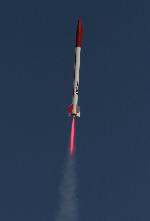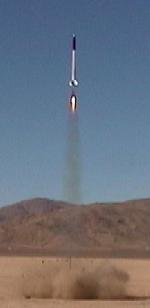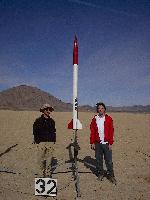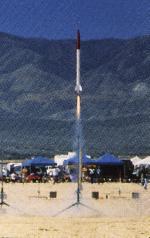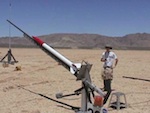Arcas
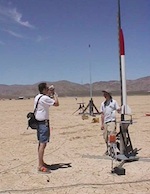
| Diameter: | 4.02" | Type: | Scale |
| Length: | 84" | Status: | Active - 18 flights |
| Motor Mount: | 76mm | Build Dates: | 2000-12-01 to 2001-06-10 |
The Aerotech Arcas was the first mid-power kit I ever had; my parents gave it to me for my 9th (I think) birthday. As such, I've always had an affinity for the HV Arcas vehicle. It's also got nice lines and plenty of stablity. So when the time came to build a "big" rocket, my mind naturally wandered towards a larger scale Arcas model. This one was built from 4" paper tubing with a 6 oz. fiberglass layer, 0.093 G10 fins, and a 76mm motor mount. It's been a very reliable dual deploy model, with over 15 flights now on everything up to 3-grain L motors.
Flights
The venerable Arcas made its 18th flight with another Aerotech L850W. The Arcas made a nice boost on the big L motor, but the slight wiggle apparent on flight #17 was a bit more pronounced; I think the cardboard is getting soft. Regardless, things made it up to apogee in pretty decent shape. Last time we flew this combo I didn't have my 20D, so the liftoff shots were limited in quality. This time, though, they came out perfect! Drogue deployment was easily visible at apogee, and we could see it all the way down--instead of getting smaller and smaller (drifting away) it was getting bigger and bigger, until the main popped and it landed gently, 20 yards behind the back row of pads. Holy cow it was calm! Perfect flight.
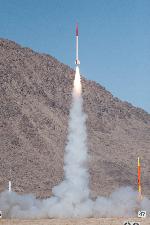
others: under drogue | touchdown!
The Arcas had been idle since 2008, so with an L1150 in the motor box I decided it was a good time to bring it out for another flight. I pulled the terminal blocks off an old ARTS 1 to repair the ARTS 2 that had been beat up over the past few months; with that task completed, prep went smoothly, using the same RRC/ARTS avionics package that has worked well for this bird so far. Everything was buttoned up and on the pad by 9 AM; Rick Dickinson called in a window to 13,000 and we were off. The red flame from the medusa nozzle was incredibly satisfying as it drove the Arcas through the sound barrier and into the clear desert sky; apogee was on time and visible, and I tracked the rocket down to main deployment altitude, where the R9 deployed like magic (as always) for a soft touchdown. A great flight for this old rocket!
Chris, my dad, and I had decided to stay the night and get a few rockets in the air the following morning at the Perchlorathon, and also watch Brent Dougherty fly his "Predator" on a huge cluster. Chris and I spent the evening coring and assembling a SPR reload for the 1400 case to fly in the Arcas; prep was leisurely and burning the red propellant scraps under the stars was fun. Sunday morning was clear and calm; we had the rocket on the pad by 10:30 and we were ready to go. SpartaChris counted down and hit the button, at which time my camera battery simultaneously died. LAME. Luckily, Matt Minjarez was on site with his 20D and totally awesome 70-200 f/2.8 lens, and grabbed a beautiful series of shots of the flight. Since the propellant was loaded with Sr(CO3)2, the burn was lovely and slow, and the red flame was awesome, eliciting comments from all present. The boost was nominal with a clean motor shutdown, and recovery went as-planned; Chris chased down the rocket with ease. Thanks dude :)
For Sunday morning, I wanted to put another L motor in the Arcas. A 3 grain slow was the weapon of choice. We were to the pad early again, and with the correct pad selected this time, ignition was on-time. The rocket flew nice and straight on a long orange plume, and recovered nominally at the north end of the range.

others: in-flight
Last month's flight ended poorly as the booster got dragged a hundred yards across the playa by a strong June breeze. My dad spent the rest of June sanding out the tube, soaking it in resin, and carefully applying reinforcement to rebuild the forward end of the tube. After this treatment and a repaint, the Arcas looked good as new - I wanted to make sure it WAS, so a K1100T was procured and the rocket prepped for a full dual deploy flight. Steve Seeright called out the countdown and kaWHAM, the K1100 catapulted the Arcas into the sky atop a seven foot blue flame. (LOVE that Copper Chromite.) She held together through the burn and up to apogee, where the drogue appeared on cue. Even though there was no wind at ground level, things must have been moving pretty good above the mountain, as the Arcas drifted quite a ways under drogue. The main appeared at 800' off in the distance, and a quick truck trip later all was recovered. Not a bad return flight!
For lucky flight 13, the Arcas went up on an AT J540R to punt it into the air while keeping it low enough to (hopefully) prevent a long recovery walk. The rocket weathercocked into the 10 mph breeze, and deployed the drogue at the 3900' apogee, with the main appearing a short while later at 800'. Upon landing, however, the poor bird got dragged to death, delaminating the forward section of lower airframe, and scratching up the paint. 'Sok, I guess, it needed a new paint job anyways, I guess. Overall, a good flight for a breezy day.
others: another angle
The slow load for the 76/2500 case is *really* slow, but it turned out to be perfect for the paper Arcas on this calm day. After a quick prep, including a discussion of the functional parts of the motor with the lab, she was on the pad and ready. I called out the count, Chris snapped photos, my dad videotaped, and the Arcas picked up off the rail nicely and headed into the light breeze. At apogee, the drogue appeared, and the main a short while later for a nice recovery near the access rut.
When I got my 76mm cases from Hulan, they came with a few reloads, including one two-grain and two three-grain Skidmarks. These were the old Skid formulation, with a dash of yellow iron oxide (rather than the heaping spoonfuls in the new AMW loads), making them really slow - and really spectacular. The 2-grain load went in the Arcas at this launch, and put on quite the show. Though it only made it to 6000 feet (as opposed to the 8k+ it should do on a full K), it was worth it!
others: me 'n eric | liftoff
video
This was the tenth flight of the venerable Arcas, and it was to be on our favorite motor for it -- the slow load for the 2550. I had spent all day after the Competitor flight hanging out and chatting with people at the launch, so prep was a bit of a race against the clock as the sun set. Just as the sun crossed the top of the ridgeline to the west of the lakebed, Gordon counted down and hit the button. The L motor lit right up and the Arcas flew off the rail and into the darkening sky. As it crested the ridgeline, the sun's rays illuminated the smoke trail and airframe, making it look like a shooting star. COOL! The drogue appeared at apogee and the main off in the distance at 1000 feet, for an easy recovery near one of the access roads to the lakebed. Another great flight. This rocket is now officially an old battlehorse!
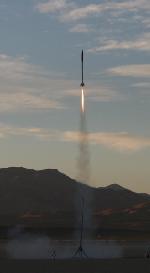
others: preflight (omg my hair!) | shooting star
video
Red motors are way cool. So when I was offered one to fly in a 76mm 3500 Ns case, I couldn't opt not to. This formula was the original "Red Rhino" from Kosdon East, I think. I prepped the rocket in record time as the day was winding down - it was about 3:00 and I had only flown one rocket (AIR on a K410). The weather was still perfect, so might as well put this one up too. I ran out to the pad and put the rocket on the rail, stood it upright, and installed an electric match with about a foot of Thermalite to get the stubborn motor to light. I returned to the rangehead and summoned Les Derkovitz to push the button. In the laid-back but safe style of Tripoli Vegas, we were ready to go almost instantly. 3, 2, 1, go. POP! The e-match fired and lit the Thermalite. The rocket began to smoke. Fffft. Ffffffffffft. Chuff. Chuff. Fffft. Roarrrrrrrrrrrrrrrrr. Finally, the rocket lifted off the rail ever so slowly and began its climb skywards - 4.19 gees according to the ARTS. I was afraid that the rocket on a six-foot rail would be hit by a wind gust at a vulnerable low speed, but the day was beautiful, and the rocket kept going straight. The motor burned for just about six seconds with a few chuffs and pops on the way up, and a LASER RED flame. Rick Magee said he was just entering the launch site when I flew, and the flame was as bright and vibrant as a Urinsco Redeye. Not bad. Eventually, the drogue appeared at apogee, and the main a short while later at 1000 feet. I recovered the rocket on foot in the bushes at the edge of Jean Dry Lake just as the sun was setting. I listened to the altimeter chirp out 10,177 feet as I hoofed it back to the rangehead. A great end to a great day of flying! Two L motors in the Arcas in one month. I never thought that would happen...
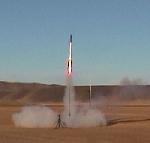
others: postflight
video
I had purchased the 3840 case from RocketSilo when they were having their closeout sale, and my parents got me the closures for my 16th birthday (thanks mom and dad!). The reload had been purchased from What's Up Hobbies in December of 2003. 2004 had been a mess weather-wise, so our first opportunity to put up the big L motor was ROCStock XX. Prep went smoothly; we started at about 9:30 and easily finished by 11:00. On to the pad with a honking big dipped igniter from Kurt Gugisberg, altimeters armed, cameras ready, and away we went. Rick DuVall got everybody's attention... "an Aerotech L-8-50!" And the count came... 5, 4, 3, 2, 1. A moment of silence, and then instantly the motor came on and the rocket tore off the pad on a seven-foot pillar of fire. It burned, and burned, and burned. The rocket kept flying on a true course through burnout and kept drilling into the sky as the delay train left a trail. Finally, a small orange dot confirmed presence of the drogue chute at the apogee of 13,681 feet. Eric Williams and I tracked it down to 1000 feet, where the main appeared on cue courtesy of MissileWorks. The ARTS fired the backup charge at 750 feet, and the rocket returned to the ground not less than 1/4 mile from the east end of the flight line without damage. A perfect flight. Oh yeah, it broke Mach too!
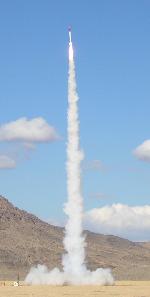
others: burnout
Well, I resolved to get the Arcas out at the beginning of the year and fly her on a K550W. Due to certain circumstances (hint: J570W, separation, and yokels with shotguns!), that flight never materialized. I couldn't attend February or March launches (school musical) and April I ran out of time (finicky hybrid pad). May I wanted to take a break from complex rockets, and finally June rolled around. I had an unusual opportunity, though. I recently got ahold of some 1700 Ns 76mm hardware. What better rocket to try it out in? I loaded up the case with 1 grain of fast propellant and one grain of black smokey propellant, christened the motor a K300, and shoved it in the back of the Arcas. With easy prep, aided by a nice new G10 altimeter board, we had the rocket on the pad by 10:00. A quick countdown and the button was pushed. The rocket sat and thought about it for a second, then it began. Orange flame spewed from the base of the rocket as the motor pressurized. The fast grain lit first and took the rocket off the pad s-l-o-w-l-y (4.5 gees according to the ARTS) on its characteristic yellow tongue of flame. At 54 feet in the air (ARTS data is great!), the motor POPPED and the smoky grain kicked in. The acceleration increased to a max of 6 gees and the rocket continued its ride up to apogee, sputtering and spewing out orange flame and black smoke the whole way. It probably wasn't the most effective use of propellant, but let me try to describe to you the reaction I got from everyone at the site: WOW! COOL! WAY COOL! After burnout, the 29mm smoke element provided plenty of tracking smoke up to apogee, through successful drogue ejection, and also on the return trip down for about 700 feet. Main ejection was spot on at 1000 feet, and the ARTS backup went off at 750 feet as planned. Perfection!
Well, my 2550 motor got crashed (lawn darts from 18K don't do good things to aluminum ;)), so the Arcas was temporarily grounded from its upcoming L850 flight. Temporarily. Sitting around the campfire on Saturday night, Tony Alcocer offered me one of his remaining stash of "Wimpy Red" motors. This one was for a 2000 Nsec case, and simmed out to a K970. He graciously gave it to us for free (though we did give him a box of DaveyFire 28Bs for SOMETHING), or at least the propellant. I had the joy of facing, sanding, and coring the grains for the motor. I then cut the liner and Tony helped me build it all up. It fit together just like a Kosdon. The rest of the rocket was prepped with an RRC2 only for deployment (I trashed my ALTACC on Saturday too!). We put the rocket on the pad about 11:00, installed the igniter, and pushed the button. The rocket chuffed twice, then SCREAMED off the pad to 8030 feet. Wimpy, huh?! It arced over at apogee and deployed the drogue right on time, and the main deployed perfectly at 1000 feet. That was GREAT! Thanks to Tony for the motor, Paul for the prep help, and Sue McMurray for cheerleading <g>. P.S. I picked up a new 2550 motor recently - the L850S combo will get into the air again real soon!
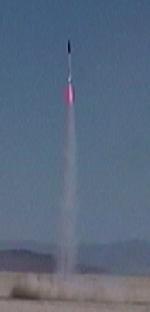
others: me 'n paul preflight | recovery
For the fifth flight of this bird, I had fixed some of the issues we were having with it - smaller nylon and new threaded inserts for the payload bay, along with shear pins to keep that main chute where it belonged. When the countdown was complete, WHAM, the motor came up to pressure, and the Arcas jumped off the pad on a beautiful Kosdon Fast Propellant flame. After a long coast to apogee, we were greeted with the orange R3 drogue, and at 1000 feet, the RRC2 again fired the main charge, for a textbook recovery. Yet another great flight. I love this rocket!
After the L1000 flight, the Arcas went into hibernation. We didn't fly it for a while-- weather, new projects, and launch schedules saw to that. But I was itching to put her back up in the air. My chance came at the Turkey Shoot in November of 2002. We had a J415 waiting for something, and this was a perfect motor for this rocket. Prep was fairly easy and relaxed, due to the massive fog at the launch site on Sunday morning. And she was ready to fly by the time the fog lifted. We put her out on pad 11, and armed altimeters, installed igniters, and snapped photos. Nadine took a photo of me standing next to the rocket too. Back at the rangehead, John Pretto called out the count and off she went. A perfectly straight boost and coast was marred when the main deployed at apogee. This was due to a bug in the ALTACC. You see, if the ALTACC's drogue charge loses continuity at ANY TIME during the flight, it immediately fires the main. Geeze. We stuck the MissileWorks drogue charge very close to the charge of the ALTACC. The charge must have sympathetically fired at apogee, and voila, no drogue continuity. There goes the main chute. This was confirmed after looking at the ALTACC data, and it showing that it was in "Main Only" flight mode. Huh. Go figure. The way to fix this would be to mount a 10k resistor across the drogue terminals whenever flying a dual deploy rocket. If the igniter loses continuity, it still reads continuity on the circuit. Oh well, it was no big deal, I just had to walk a little farther. It was a great flight.
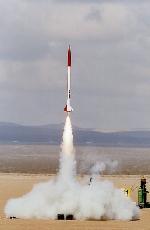
others: preflight
We flew the Arcas/L850 combo for the first time at the December 2001 ROC launch. It was a great way to close out the year. The prep work went by fast, and we were on the pad by 11:00 am. The rocket took off at around 11:10 and streaked into the sky at close to Mach 1. It went 9554 feet and 1099 ft/sec (according to the ALTACC). Once again, the dual deployment worked as planned, but the rocket came down really far away because of a breeze that day. It came back with only scratches in the paint.
At LDRS we flew the Arcas again on a Kosdon K350S-P load. This time, the rocket flew beautifully to 4400 feet, with successful dual deployment on the way down. I must say, seeing the 9 ft. Rocketman chute inflate what only seemed to be 800 feet off the ground (probably because it was) and have the rocket gently touch down just a few feet away was the most awesome sight in my whole rocketry career. I gotta try that again.
I decided to try it on a J275 for the first flight (wanted to do a K700 but dad said it was too much). Just single deployment for this flight, Missile Works on board for the ride. At the pad I was interviewed by Brent McNeely (I felt so important). It was a great flight, but never having flown something this big before, neglected to put enough tape on the separation joint. Midway through the motor burn (~1300 feet), the rocket drag separated. Oops. The payload section tumbled down on its own and the booster came down with the chute. Good products, those Sky Angles. It held together even when I threw 350 mph into it. The only major damage done was a (rather large) zipper down the side of the booster, and the payload coupler cracking.

